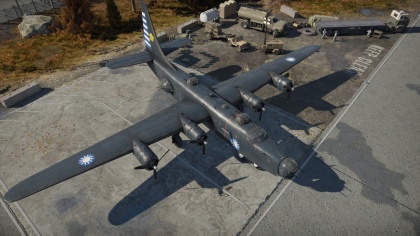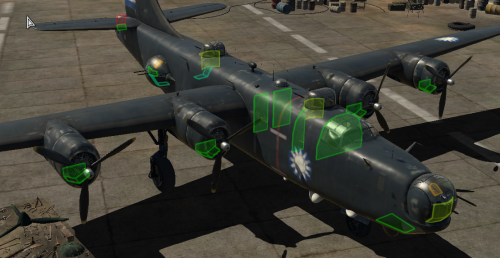PB4Y-2 (China)
Contents
| This page is about the aircraft PB4Y-2 (China). For other uses, see B-24/PB4Y (Family). |
Description
The ␗PB4Y-2 Privateer is a rank Chinese bomber
with a battle rating of (AB), (RB), and (SB). It was introduced in Update 1.91 "Night Vision".
General info
Flight performance
Describe how the aircraft behaves in the air. Speed, manoeuvrability, acceleration and allowable loads - these are the most important characteristics of the vehicle.
| Characteristics | |||||||
|---|---|---|---|---|---|---|---|
| Stock | |||||||
| Max Speed (km/h at 7,620 m) |
Max altitude (meters) |
Turn time (seconds) |
Rate of climb (meters/second) |
Take-off run (meters) | |||
| AB | RB | AB | RB | AB | RB | ||
| ??? | ??? | ??.? | ??.? | ??.? | ??.? | 950 | |
| Upgraded | |||||||
| Max Speed (km/h at 7,620 m) |
Max altitude (meters) |
Turn time (seconds) |
Rate of climb (meters/second) |
Take-off run (meters) | |||
| AB | RB | AB | RB | AB | RB | ||
| ??? | ??? | ??.? | ??.? | ??.? | ??.? | 950 | |
Details
| Features | ||||
|---|---|---|---|---|
| Combat flaps | Take-off flaps | Landing flaps | Air brakes | Arrestor gear |
| X | ✓ | ✓ | X | X |
| Limits | ||||
|---|---|---|---|---|
| Wing-break speed (km/h) |
Gear limit (km/h) |
Combat flaps (km/h) |
Max Static G | |
| + | - | |||
| 394 | ~3 | ~1 | ||
| Optimal velocities | |||
|---|---|---|---|
| Ailerons (km/h) |
Rudder (km/h) |
Elevators (km/h) |
Radiator (km/h) |
| < 200 | < 180 | < 180 | > 300 |
| Compressor (RB/SB) | ||
|---|---|---|
| Setting 1 | ||
| Optimal altitude | 100% Engine power | WEP Engine power |
| 2,346 m | 1,100 hp | 1,331 hp |
| Setting 2 | ||
| Optimal altitude | 100% Engine power | WEP Engine power |
| 4,389 m | 1,000 hp | 1,133 hp |
Survivability and armour
The PB4Y has a lot of armour and also has self-sealing fuel tanks. The self-sealing tanks are located where the wings and fuselage meet.
Armaments
Suspended armament
The PB4Y-2 (China) can be outfitted with the following ordinances:
- 20 x 100 lb AN-M30A1 bombs (2000 lb total)
- 8 x 500 lb AN-M64A1 bombs (4000 lb total)
- 4 x 1000 lb AN-M65A1 bombs (4000 lb total)
- 8 x 1000 lb AN-M65A1 bombs (8000 lb total)
- 4 x 2000 lb AN-M66A2 bombs (8000 lb total)
Defensive armament
The PB4Y-2 (China) is equipped with six turrets each with dual-mounted M2 Brownings (Total ammo 5120)
| 12.7 mm M2 Browning | |||||
|---|---|---|---|---|---|
| Mount | Total Ammo | Fire rate | Vertical guidance | Horizontal guidance | |
| Nose | 600 | 750 | -55°/+70° | ±80° | |
| Dorsal | 380 | -0°/+67° | ±180° | ||
| Waist | 400 | -95°/+55° | -55°/+80° | ||
| Tail | 400 | ±70° | -41°/+70° | ||
Usage in battles
There are two ways you can go about playing the ␗PB4Y-2 Privateer, side climbing or diving.
- Side climbing
Side climbing is the safest way of going about. Start by spawning with your Heavy Bomber air spawn, and climb away from the battle. This will give your fighters enough to time to climb up and duel with the enemies. After you see most of the enemies at low alt, you are safe to go in and bomb a point and return-to-base. With side-climbing, the chance to reaching the bombing point is significantly higher as altitude is gained and it becomes less likely the enemy fighters will locate the PB4Y-2. However, side climbing will take up a lot of time and can end with the game ending before reaching the bombing point, or the team decimated.
- Diving
Diving is probably the most risky way of trying to bomb but it is the quickest if you do it right. Start by spawning in then dive at about 10 degrees. This will make sure you will not overspeed before reaching the bombing point.
Diving will also remove the defensive blind spot on the belly when staying low, as it is less likely a fighter will intercept from below. If a fighter decides to come down and attack, they lose their altitude and so friendly fighters can pounce on them more easily.
However, the last point of fighters coming down may end up attracting the whole enemy team, and dealing with a swarm of enemy fighters is no one's desired outcome. At a low altitude, ground elements like anti-aircraft could also have a better chance of hitting the plane.
Overall, this usage is more risky than maintaining altitude and bombing, but it could be rewarding if pulled off successfully.
Manual Engine Control
| MEC elements | ||||||
|---|---|---|---|---|---|---|
| Mixer | Pitch | Radiator | Supercharger | Turbocharger | ||
| Oil | Water | Type | ||||
| Controllable | Controllable Auto control available |
Not controllable Not auto controlled |
Controllable Not auto controlled |
Combined | Controllable 2 gears |
Not controllable |
Pros and cons
Pros:
- Great defensive armament
- Good payload
- Almost full coverage from the turrets
Cons:
- Very slow
- Big target
- Tail is prone to being shot off
History
Describe the history of the creation and combat usage of the aircraft in more detail than in the introduction. If the historical reference turns out to be too long, take it to a separate article, taking a link to the article about the vehicle and adding a block "/History" (example: https://wiki.warthunder.com/(Vehicle-name)/History) and add a link to it here using the main template. Be sure to reference text and sources by using <ref></ref>, as well as adding them at the end of the article with <references />. This section may also include the vehicle's dev blog entry (if applicable) and the in-game encyclopedia description (under === In-game description ===, also if applicable).
Media
Excellent additions to the article would be video guides, screenshots from the game, and photos.
See also
Links to the articles on the War Thunder Wiki that you think will be useful for the reader, for example:
- reference to the series of the aircraft;
- links to approximate analogues of other nations and research trees.
External links
Paste links to sources and external resources, such as:
- topic on the official game forum;
- encyclopedia page on the aircraft;
- other literature.
| China bombers | |
|---|---|
| American | Martin 139WC*(␗B-10B) · ␗A-29 · ␗B-25J-30 · ␗PB4Y-2 |
| German | ␗Hs 123 A-1 |
| Soviet | ␗SB 2M-103U · ␗DB-3A · ␗Tu-2S-44 · ␗Tu-4 |
| Japanese | ␗P1Y1 mod. 11 |
| *Export Name | |






